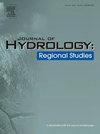基于遥感和深度学习预测未来蒸散量
IF 4.7
2区 地球科学
Q1 WATER RESOURCES
引用次数: 0
摘要
研究区域选择美国四个通量站点的流域作为本研究的研究区域。研究重点本研究验证了卷积长短期记忆网络(ConvLSTM)模型在站点尺度蒸散发预测中的效率。我们通过添加空间金字塔汇集模块(SPPM)和多头自注意力模块(MSA-Module)增强了 ConvLSTM 模型,创建了多头自注意力 ConvLSTM(MSA-ConvLSTM)模型,并将其应用于预测区域尺度的实际蒸散量(ETa)。本研究旨在探讨 MSA-ConvLSTM 模型能否在考虑多个特征变量的情况下提高预测区域尺度 ETa 的准确性。此外,我们还评估了不同的性能指标,讨论了区域 ETa 预测误差的可能原因,并对模型特征进行了敏感性分析。 MSA-ConvLSTM 模型准确预测了 ETa 的未来状态。平均 R2 为 0.81,分别比 ConvLSTM 和 Self-Attention ConvLSTM(SA-ConvLSTM)模型高 11.6 % 和 5.5 %。平均 RMSE 为 11.94 mm/m,分别比 ConvLSTM 和 SA-ConvLSTM 低 21.5 % 和 13.7 %。平均 MAE 为 9.46 mm/m,分别比 ConvLSTM 和 SA-ConvLSTM 低 21.3 % 和 13 %。多头自我关注模块的加入增强了模型全面理解输入数据特征的能力。这一改进使模型能够更好地适应不同尺度和角度的特征关系,从而增强其表征能力,并能有效适应复杂的环境变化。本文章由计算机程序翻译,如有差异,请以英文原文为准。
Predicting future evapotranspiration based on remote sensing and deep learning
Study region
The watersheds of the four flux sites in the United States were selected as the study areas for this research.
Study focus
This study validates the efficiency of Convolutional Long Short-Term Memory Network (ConvLSTM) models for site-scale prediction. We enhanced the ConvLSTM model by adding a Spatial Pyramid Pooling module (SPPM) and a Multi-head Self-Attention Module (MSA-Module), creating the Multi-head Self-Attention ConvLSTM (MSA-ConvLSTM) model, which we applied to predicting regional-scale actual evapotranspiration (). This study aims to investigate whether the MSA-ConvLSTM model can enhance the accuracy of predicting regional-scale , considering multiple feature variables. Furthermore, we evaluated different performance indicators, discussed possible reasons for errors in regional prediction, and conducted sensitivity analysis of the model characteristics.
New hydrological insights for the region
The MSA-ConvLSTM model accurately predicts the future state of . The average was 0.81, which is 11.6 % and 5.5 % higher than those of the ConvLSTM and Self-Attention ConvLSTM (SA-ConvLSTM) models, respectively. The average RMSE is 11.94 mm/m, which is 21.5 % and 13.7 % lower than ConvLSTM and SA-ConvLSTM, respectively. The average MAE is 9.46 mm/m, which is 21.3 % and 13 % lower than ConvLSTM and SA-ConvLSTM, respectively. Incorporating of a multi-head self-attention module enhances the model’s capacity for comprehensive understanding of input data features. This improvement allows the model to better adapt to feature relationships at varying scales and angles, enhancing its representational capacity and enabling effective adaptation to complex environmental changes.
求助全文
通过发布文献求助,成功后即可免费获取论文全文。
去求助
来源期刊

Journal of Hydrology-Regional Studies
Earth and Planetary Sciences-Earth and Planetary Sciences (miscellaneous)
CiteScore
6.70
自引率
8.50%
发文量
284
审稿时长
60 days
期刊介绍:
Journal of Hydrology: Regional Studies publishes original research papers enhancing the science of hydrology and aiming at region-specific problems, past and future conditions, analysis, review and solutions. The journal particularly welcomes research papers that deliver new insights into region-specific hydrological processes and responses to changing conditions, as well as contributions that incorporate interdisciplinarity and translational science.
 求助内容:
求助内容: 应助结果提醒方式:
应助结果提醒方式:


